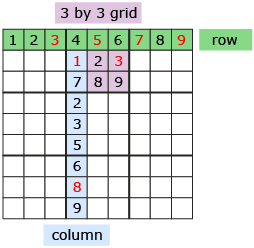Lesson 3
1. Lesson 3
1.5. Explore 4
Module 2: Number
The previous problems have highlighted a number of strategies for solving puzzles:
Strategy |
Example Problems |
Draw a picture |
|
Create a table to organize information |
|
Logic |
|
Note that logical reasoning was used in all of the puzzles. The logical reasoning you used was the process of drawing conclusions based on the information given. When solving puzzles you may use a variety of strategies that use logical reasoning.
Following are some strategies that may be useful:
- looking for patterns
- guessing and checking
- eliminating possibilities
- working backwards
- simplifying or rewording the original problem
In the next Self-Check you will have a chance to use logical reasoning to solve a puzzle game.
Self-Check 3

iStockphoto/Thinkstock
Sudoku is a popular puzzle game where a player completes a given, partially completed, 9 by 9 grid by filling in the missing numbers. The 9 by 9 grid is broken into smaller 3 by 3 regions. Each row, column, and region contains nine cells each. The numbers 1 to 9 are filled in to complete the puzzle. The rules for Sudoku are as follows:
- Each row of the 9 by 9 grid contains the numbers 1 through 9 only once.
- Each column of the 9 by 9 grid contains the numbers 1 through 9 only once.
- Each 3 by 3 smaller grid contains the numbers 1 through 9 only once.

![]()
-
Search the Internet for a Sudoku game (use the keywords “wolfram sudoku demo” as your search term). Open the game and set the difficulty to a low number, such as 20, and try to complete the puzzle and check your answers. Once you have solved that puzzle, increase the difficulty and try again.
- Explain and verify a strategy you used to solve the Sudoku game. Answer